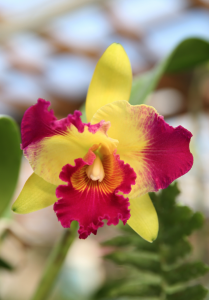A Brief Overview of the Genus Cattleya
Author: Celeste BoothNo Comments

Cattleya orchids (pronounced KAT-lee-ah) are popular because of their beautiful full blooms, enchanting smell, and ease of maintenance and care. Cattleya blossoms were the go-to flower for formal corsages, when that was a popular tradition. Their shape and smell make them a pleasing choice for special occasions. They range in color from the classic orchid lavender to white, red, yellow, orange, and green. Today, Cattleyas can be found growing in homes all over the world.
Naming of the genus: Cattleya
The genus Cattleya is comprised of over 40 species (and many more hybrids) and is endemic to Central and South America. The first published records of blooming Cattleyas in Europe are from the early 1800s. These orchids were part of private collections that had been brought over from South America.
Mr. William Cattley, who was one of the first to establish an exotic orchid collection, owned one of these first orchid plants (brought over from Brazil). When his orchid flowered, he sent it to Dr. John Lindley (orchidologist) to be analyzed. Dr. Lindley described this orchid as a Cattleya labiata, thus establishing this new genus, Cattleya, named in honor of Mr. Cattley.
Plant Identification
A typical Cattleya flower consists of three narrow sepals, and three larger petals. The bottom large petal is the lip, marked with various specks and a fringed edge folded into a tube-like shape. The number of flowers a Cattleya produces may vary from one to ten. Although the flowers naturally come in a wide array of colors, they do not produce pure black or blue flowers.
There are two categories that Cattleyas fall into: monofoliates (having one leaf) and bifoliates (having two or more leaves). Interestingly, monofoliates only produce 1-4 blossoms, while bifoliates produce many more, although smaller in size.
General Care Requirements
LIGHT: Cattleya orchids require high light (2000-3000 foot-candles) and placing them in an east or west window is a good idea. Cattleyas that do not have enough light will not bloom easily.
TEMPERATURE: They enjoy temperatures between 70-85ºF during the day, and do well when evening temperatures dip down to mid 50s to low 60s.
WATER: Cattleya orchids store water in their psudeobulbs, and therefore you can let the soil dry out between waterings so as not to overwater. Watering every week to ten days is usually a good rule of thumb. Be sure to water seedlings and younger Cattleya plants more often, as they haven’t yet reached the maturity to store as much water as adult plants.
POTTING: Cattleya orchids can be repotted every three years or so after their spring flowering is over. Use a coarse potting medium and pack firmly.


Ask an Expert
Questions about orchids?
Our experts love a challenge!
Photo of the Week
Submit your photo to be featured on the blog!
More Photo of the Week Winners
Submit Photo







